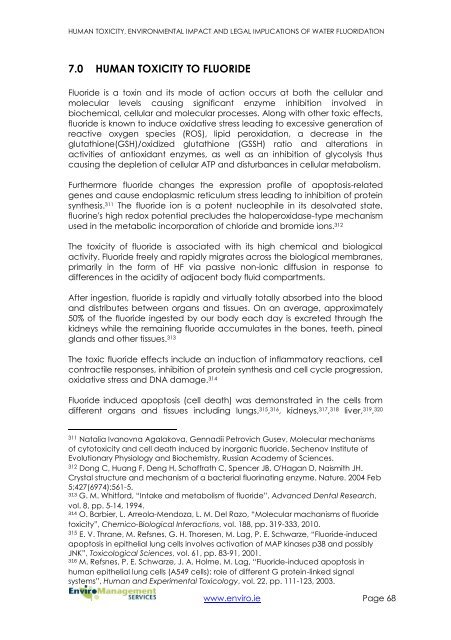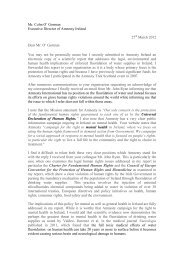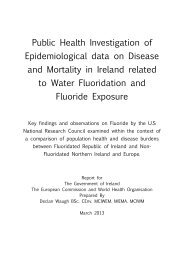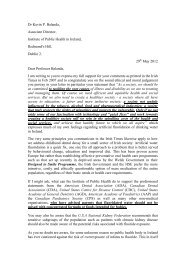Human Toxicity, Environmental Impact and Legal Implications of
Human Toxicity, Environmental Impact and Legal Implications of
Human Toxicity, Environmental Impact and Legal Implications of
Create successful ePaper yourself
Turn your PDF publications into a flip-book with our unique Google optimized e-Paper software.
HUMAN TOXICITY, ENVIRONMENTAL IMPACT AND LEGAL IMPLICATIONS OF WATER FLUORIDATION<br />
7.0 HUMAN TOXICITY TO FLUORIDE<br />
Fluoride is a toxin <strong>and</strong> its mode <strong>of</strong> action occurs at both the cellular <strong>and</strong><br />
molecular levels causing significant enzyme inhibition involved in<br />
biochemical, cellular <strong>and</strong> molecular processes. Along with other toxic effects,<br />
fluoride is known to induce oxidative stress leading to excessive generation <strong>of</strong><br />
reactive oxygen species (ROS), lipid peroxidation, a decrease in the<br />
glutathione(GSH)/oxidized glutathione (GSSH) ratio <strong>and</strong> alterations in<br />
activities <strong>of</strong> antioxidant enzymes, as well as an inhibition <strong>of</strong> glycolysis thus<br />
causing the depletion <strong>of</strong> cellular ATP <strong>and</strong> disturbances in cellular metabolism.<br />
Furthermore fluoride changes the expression pr<strong>of</strong>ile <strong>of</strong> apoptosis-related<br />
genes <strong>and</strong> cause endoplasmic reticulum stress leading to inhibition <strong>of</strong> protein<br />
synthesis. 311 The fluoride ion is a potent nucleophile in its desolvated state,<br />
fluorine's high redox potential precludes the haloperoxidase-type mechanism<br />
used in the metabolic incorporation <strong>of</strong> chloride <strong>and</strong> bromide ions. 312<br />
The toxicity <strong>of</strong> fluoride is associated with its high chemical <strong>and</strong> biological<br />
activity. Fluoride freely <strong>and</strong> rapidly migrates across the biological membranes,<br />
primarily in the form <strong>of</strong> HF via passive non-ionic diffusion in response to<br />
differences in the acidity <strong>of</strong> adjacent body fluid compartments.<br />
After ingestion, fluoride is rapidly <strong>and</strong> virtually totally absorbed into the blood<br />
<strong>and</strong> distributes between organs <strong>and</strong> tissues. On an average, approximately<br />
50% <strong>of</strong> the fluoride ingested by our body each day is excreted through the<br />
kidneys while the remaining fluoride accumulates in the bones, teeth, pineal<br />
gl<strong>and</strong>s <strong>and</strong> other tissues. 313<br />
The toxic fluoride effects include an induction <strong>of</strong> inflammatory reactions, cell<br />
contractile responses, inhibition <strong>of</strong> protein synthesis <strong>and</strong> cell cycle progression,<br />
oxidative stress <strong>and</strong> DNA damage. 314<br />
Fluoride induced apoptosis (cell death) was demonstrated in the cells from<br />
different organs <strong>and</strong> tissues including lungs, 315 , 316 , kidneys, 317 , 318 liver, 319 , 320<br />
311 Natalia Ivanovna Agalakova, Gennadii Petrovich Gusev, Molecular mechanisms<br />
<strong>of</strong> cytotoxicity <strong>and</strong> cell death induced by inorganic fluoride, Sechenov Institute <strong>of</strong><br />
Evolutionary Physiology <strong>and</strong> Biochemistry, Russian Academy <strong>of</strong> Sciences.<br />
312 Dong C, Huang F, Deng H, Schaffrath C, Spencer JB, O'Hagan D, Naismith JH.<br />
Crystal structure <strong>and</strong> mechanism <strong>of</strong> a bacterial fluorinating enzyme. Nature. 2004 Feb<br />
5;427(6974):561-5.<br />
313 G. M. Whitford, ―Intake <strong>and</strong> metabolism <strong>of</strong> fluoride‖, Advanced Dental Research,<br />
vol. 8, pp. 5-14, 1994.<br />
314 O. Barbier, L. Arreola-Mendoza, L. M. Del Razo, ―Molecular machanisms <strong>of</strong> fluoride<br />
toxicity‖, Chemico-Biological Interactions, vol. 188, pp. 319-333, 2010.<br />
315 E. V. Thrane, M. Refsnes, G. H. Thoresen, M. Lag, P. E. Schwarze, ―Fluoride-induced<br />
apoptosis in epithelial lung cells involves activation <strong>of</strong> MAP kinases p38 <strong>and</strong> possibly<br />
JNK‖, Toxicological Sciences, vol. 61, pp. 83-91, 2001.<br />
316 M. Refsnes, P. E. Schwarze, J. A. Holme, M. Lag, ―Fluoride-induced apoptosis in<br />
human epithelial lung cells (A549 cells): role <strong>of</strong> different G protein-linked signal<br />
systems‖, <strong>Human</strong> <strong>and</strong> Experimental Toxicology, vol. 22, pp. 111-123, 2003.<br />
www.enviro.ie Page 68






